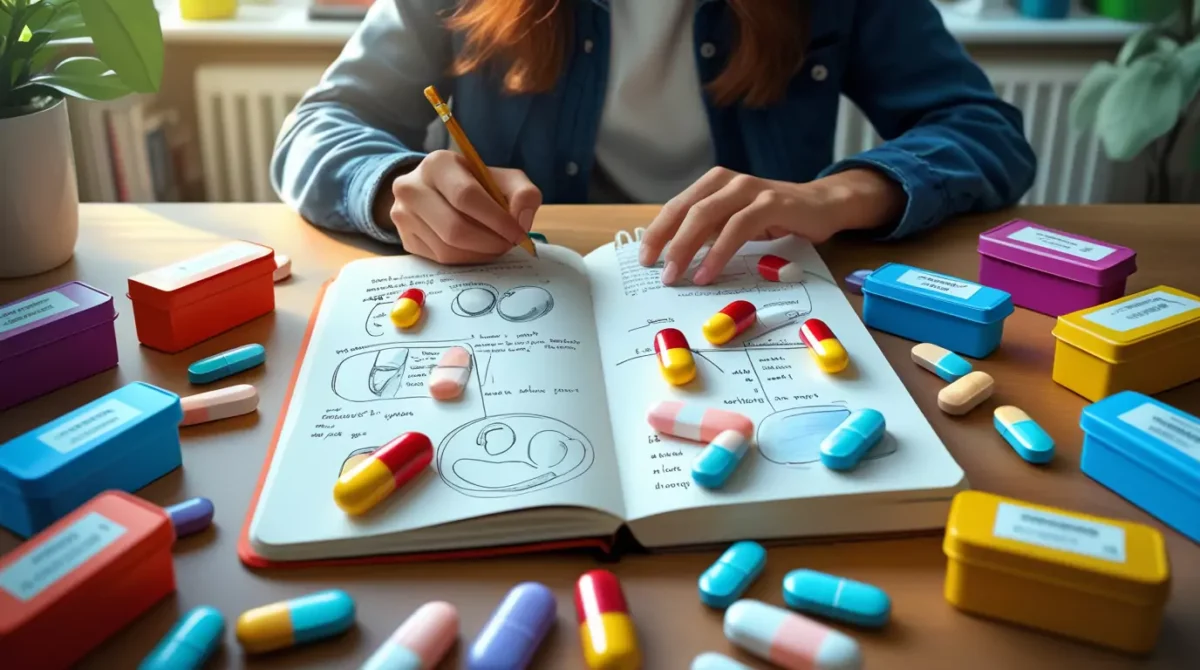You’re staring at your pharmacology textbook.
- Why Drug Names Feel Impossible to Remember
- The Pattern Recognition Method (My Personal Favourite)
- Antibiotics ending in -mycin
- Blood pressure meds ending in -pril
- Pain killers ending in -fen
- 💖 You Might Also Like
- The Story Method That Never Fails
- The Association Game
- Memory Palace for Drug Classifications
- ✨ More Stories for You
- The Breakdown Strategy
- Flashcard System That Actually Works
- Common Mistakes That Kill Your Progress
- 🌟 Don't Miss These Posts
- Quick Reference: Drug Name Endings Cheat Sheet
- Antibiotics
- Heart Medications
- Pain Relief
- Mental Health
- The 5-Minute Daily Drill
- Advanced Technique: The Sound-Alike Method
- Real-World Application Tips
- Quick Wins for Tomorrow
- Frequently Asked Questions (FAQs)
- How long does it take to remember drug names easily?
- Should I memorize generic or brand names first?
- What if I forget a drug name during exams?
- How many drug names should I learn per day?
- Do medical students use these techniques?
- Can I use these methods for other subjects?
- Your Next Steps
Your brain feels like mush.
These drug names look like someone threw alphabet soup at a wall.
I get it.
I’ve been there too.
How to remember drug names easily isn’t rocket science.
But most people are doing it wrong.
Let me show you what actually works.
Why Drug Names Feel Impossible to Remember
Here’s the thing nobody tells you.
Your brain wasn’t designed to remember random letter combinations.
Paracetamol, Azithromycin, Metformin.
These aren’t words.
They’re code.
And your brain treats them like spam.
That’s why you forget them 5 seconds after reading.
The Pattern Recognition Method (My Personal Favourite)
Most drug names aren’t random.
They follow patterns.
Once you see these patterns, everything clicks.
Antibiotics ending in -mycin
- Azithromycin
- Clarithromycin
- Erythromycin
See it?
They’re all from the same family.
Macrolide antibiotics.
Blood pressure meds ending in -pril
- Lisinopril
- Enalapril
- Captopril
ACE inhibitors.
All of them.
Pain killers ending in -fen
- Ibuprofen
- Diclofenac sodium
- Ketoprofen
NSAIDs.
Every single one.
Pro tip: Make a cheat sheet of these endings.
Your memory will thank you later.
💖 You Might Also Like
The Story Method That Never Fails
Here’s what I did during my pharmacy days.
I turned drug names into stories.
Example 1: Paracetamol
Para = Parallel Ceta = Acetyl
Mol = Molecule
“The parallel acetyl molecule that fights fever”
Sounds silly?
It works.
Example 2: Metformin
Met = Meeting For = For Min = Minutes
“Meeting diabetes for minutes” (because it lowers blood sugar quickly)
Your brain loves stories.
Give it stories.
The Association Game
Link new drug names to things you already know.
Aspirin → A-Spear-In (imagine throwing a spear at pain)
Insulin → In-Su-Lin (imagine Lin from your neighbourhood who’s always “in” to help with sugar)
Warfarin → War-Far-In (fighting clots from far within)
Make it visual.
Make it weird.
Weird sticks.
Memory Palace for Drug Classifications
I use my house to remember drug categories.
Kitchen = Antibiotics
- Amoxicillin lives in the fridge
- Ciprofloxacin sits on the gas stove
- Azithromycin hangs out near the sink
Bedroom = Pain medications
- Morphine sleeps on my bed
- Tramadol rests on the pillow
- Codeine chills on the nightstand
Living room = Heart medications
- Atenolol relaxes on the sofa
- Amlodipine sits by the TV
- Digoxin guards the main door
Walk through your house.
Place each drug somewhere logical.
Visit daily.
✨ More Stories for You
The Breakdown Strategy
Long drug names scare people.
Break them down.
Chloramphenicol
- Chlor (chlorine)
- Amphen (amphetamine sound)
- Icol (alcohol ending)
Dextromethorphan
- Dextro (right-handed)
- Metho (method)
- Rphan (orphan sound)
Smaller pieces = easier memory.
Flashcard System That Actually Works
Most people make boring flashcards.
Don’t be most people.
Front of card: Drug name + silly drawing
Back of card:
- What it does
- Your story/association
- One real-world example
Example card for Insulin:
Front: INSULIN (draw a key unlocking a sugar cube)
Back:
- Unlocks cells to let glucose in
- “In-Su-Lin helps sugar get in”
- Used by my uncle who has diabetes
Review daily.
Not weekly.
Daily.
Common Mistakes That Kill Your Progress
Mistake 1: Trying to memorize everything at once
Don’t.
Pick 5 drugs per day.
Master them.
Then move on.
Mistake 2: Ignoring generic vs brand names
Paracetamol = Crocin = Dolo
Same drug.
Different names.
Know both.
Mistake 3: Not connecting to real patients
Every drug has a face.
My grandmother takes Metformin.
My friend uses Salbutamol inhaler.
Real connections = lasting memory.
🌟 Don't Miss These Posts
Quick Reference: Drug Name Endings Cheat Sheet
Antibiotics
- -cillin (Penicillins)
- -mycin (Macrolides)
- -floxacin (Fluoroquinolones)
Heart Medications
- -pril (ACE inhibitors)
- -sartan (ARBs)
- -olol (Beta blockers)
Pain Relief
- -fen (NSAIDs)
- -caine (Local anaesthetics)
- -done (Opioids)
Mental Health
- -pine (Some antidepressants)
- -pam (Benzodiazepines)
- -zole (Some antipsychotics)
Print this.
Stick it on your wall.
Thank me later.
The 5-Minute Daily Drill
Every morning, before your chai.
Pick 5 drug names.
Write them down.
Create associations.
Tell yourself the stories.
5 minutes.
That’s it.
Do this for 30 days.
You’ll know 150 drug names by heart.
Advanced Technique: The Sound-Alike Method
Find drugs that sound like regular words.
Atorvastatin → “A-Tor-Was-Statin” (A tour was starting)
Levothyroxine → “Levo-Thy-Rock-Scene” (Left thy rock scene)
Simvastatin → “Sim-Was-Statin” (Sim was stating)
Your brain processes sounds faster than spellings.
Use it.
Real-World Application Tips
During ward rounds:
- Whisper the story to yourself
- Connect the drug to the patient’s condition
- Note how it’s pronounced by seniors
While studying:
- Say drug names out loud
- Write them without looking
- Teach them to a study buddy
In exams:
- Close your eyes
- Visualize your memory palace
- Walk through room by room
Quick Wins for Tomorrow
Start with these 10 common drugs:
- Paracetamol – Para(llel) pain relief
- Aspirin – A spear in pain
- Amoxicillin – A-mox-i-kill-in (kills bacteria)
- Metformin – Met diabetes for minutes
- Atenolol – Ate-no-lol (serious heart med, no laughing)
- Omeprazole – Om-praise-ole (praise for acid relief)
- Insulin – In-su-lin (sugar goes in)
- Salbutamol – Sal-but-a-mol (but a molecule for breathing)
- Diclofenac – Dick-low-fen-ac (low pain, high relief)
- Ciprofloxacin – Cipro-flocks-a-sin (flocks against infection)
Practice these today.
Master them this week.
Frequently Asked Questions (FAQs)
How long does it take to remember drug names easily?
With consistent practice, 2-3 weeks.
But here’s the catch.
You need to practice daily.
Not when you feel like it.
Daily.
Should I memorize generic or brand names first?
Generic names first.
Always.
Brand names change by company.
Generic names stay the same worldwide.
What if I forget a drug name during exams?
Stay calm.
Close your eyes.
Go to your memory palace.
Walk through the rooms.
The association will come back.
How many drug names should I learn per day?
Start with 5.
Once that feels easy, bump it to 10.
Never more than 15.
Your brain has limits.
Respect them.
Do medical students use these techniques?
The smart ones do.
The average ones cram.
Guess who performs better?
Can I use these methods for other subjects?
Absolutely.
Anatomy, physiology, pathology.
The techniques work everywhere.
Memory is memory.
Your Next Steps
Stop reading.
Start doing.
Pick 5 drug names right now.
Create associations for each.
Write them down.
Review them before bed.
That’s how you begin to remember drug names easily.
No fancy apps needed.
No expensive courses required.
Just you, a pen, and these proven methods.
Your future self will thank you.
Trust me on this.



















